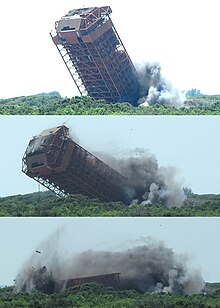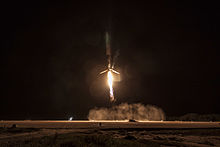 Atlas with Mariner 3 at Launch Complex 13 prior to launch on 4 November 1964 Atlas with Mariner 3 at Launch Complex 13 prior to launch on 4 November 1964 | |||||||||||
| Launch site | Cape Canaveral Space Force Station | ||||||||||
|---|---|---|---|---|---|---|---|---|---|---|---|
| Location | 28°29′09″N 80°32′40″W / 28.4859°N 80.5444°W / 28.4859; -80.5444 | ||||||||||
| Time zone | UTC−05:00 (EST) | ||||||||||
| • Summer (DST) | UTC−04:00 (EDT) | ||||||||||
| Short name | LC-13 | ||||||||||
| Operator | US Space Force NASA | ||||||||||
| Total launches | 52 | ||||||||||
| Launch pad(s) | One | ||||||||||
| |||||||||||
Launch Complex 13 (LC-13) was a launch complex at Cape Canaveral Space Force Station (CCAS), the third-most southerly of the original launch complexes known as Missile Row, lying between LC-12 and LC-14. In 2015, the LC-13 site was leased by SpaceX and was renovated for use as Landing Zone 1 and Landing Zone 2, the company's East Coast landing location for returning Falcon 9 and Falcon Heavy launch vehicle booster stages. It is leased by US Space Force to Phantom Space and Vaya Space who will operate this launch complex after the termination of SpaceX's lease in future.
LC-13 was originally used for test launches of the SM-65 Atlas and subsequently for operational Atlas launches from 1958 to 1978. It was the most-used and longest-serving of the original four Atlas pads. It was inactive between 1980 and 2015.
On 16 April 1984, it was added to the US National Register of Historic Places; however it was not maintained and gradually deteriorated. On 6 August 2005 the mobile service tower was demolished as a safety precaution due to structural damage by corrosion. The blockhouse was demolished in 2012.
LC-13 was on land owned by the US government and was originally controlled by the United States Air Force. It was transferred to NASA in 1964 and back to the Air Force in 1970. In January 2015, the land and remaining facilities at LC-13 were leased to SpaceX for a five-year lease.
Rocket configuration (LC-13)
3 6 9 12 15 1960 1965 1970 1975Rocket configuration (LZ-1)
This section is transcluded from Landing Zones 1 and 2. (edit | history) 2.5 5 7.5 10 12.5 15 2015 '16 '17 '18 '19 '20 '21 '22 '23 '24- Falcon 9 Success
- Falcon Heavy Success
- Falcon 9 Failure
- Falcon Heavy Failure
Rocket configuration (LZ-2)
This section is transcluded from Landing Zones 1 and 2. (edit | history) 1 2 3 4 2015 '16 '17 '18 '19 '20 '21 '22 '23 '24- Falcon 9 Success
- Falcon Heavy Success
- Falcon 9 Failure
- Falcon Heavy Failure
Launch Complex 13
Together with Launch Complexes 11, 12 and 14, LC-13 featured a more robust design than many contemporary pads due to the greater power of the Atlas compared to other rockets of the time. It was larger and featured a concrete launch pedestal that was 6 metres (20 ft) tall and a reinforced blockhouse. The rockets were delivered to the launch pad by a ramp on the south side of the launch pedestal.
1956-1961 Atlas Missile tests
Starting in 1958, Atlas B, D, E and F missiles were tested from the complex.
One on-pad explosion occurred, the launch of Missile 51D in March 1960, which suffered combustion instability within seconds of launch. The Atlas fell back onto LC-13 in a huge fireball, putting the pad out of commission for the entire spring and summer of 1960.
Prior to the launch of Atlas 51D, the separate turbine exhaust ducts had been removed from the four Atlas pads at CCAS. A few weeks later, another Atlas exploded on LC-11 and it was then decided to reinstall the exhaust ducts, although it was considered unlikely that they had anything to do with the failures.
The next launch hosted from LC-13 was the first Atlas E test on October 11, exactly seven months after the accident with Missile 51D. Afterwards, LC-13 remained the primary East Coast testing site for Atlas E missiles, with Atlas F tests mainly running from LC-11 (Missile 2F in August 1961 was the only F-series Atlas launched from LC-13).
1962–1978 Atlas Agena

Between February 1962 and October 1963 the pad was converted for use by Atlas-Agena. The modifications were more extensive than the conversions of LC-12 and LC-14 with the mobile service tower being demolished and replaced with a new, larger tower. The first launch from the renovated pad was Vela 1 on October 17, 1963.
Significant launches included:
- Lunar Orbiter 1 on 10 August 1966. It photographed proposed landing sites for Apollo and Surveyor spacecraft on the Moon, and returned the first pictures of the Earth from lunar orbit.
- Several classified payloads for the National Reconnaissance Office, believed to include Canyon and Rhyolite satellites.
The final launch from LC-13 was a Rhyolite satellite on 7 April 1978, using an Atlas-Agena.
The pad was deactivated from 1980 to 2015.
Landing Zones 1 and 2
Main article: Landing Zones 1 and 2
The site of the former Launch Complex 13 is now leased to SpaceX, and designated as Landing Zones 1 and 2.
SpaceX signed a five-year lease for the land at the former Launch Complex 13 on 10 February 2015 to use the area to land reusable launch vehicles. The company originally planned to convert the old Atlas launch facility into a set of five discrete landing pads, one large primary pad with four smaller alternate pads surrounding it. However, this plan was changed to only include two pads which have already been built at the landing complex.
SpaceX accomplished its first successful landing at the complex on the Falcon 9 Flight 20 mission, which occurred on 22 December 2015 UTC.
Notes
- The original four Atlas pads were LC-11, 12, 13 and 14.
- The structure was so unstable that it could not be safely dismantled and had to be toppled by a controlled explosion before it could be taken apart. This has since become the standard method of dismantling launch complexes at Cape Canaveral and was used in the demolition of LC-41, LC-36 and LC-40.
References
- William Graham (March 28, 2022). ""Missile Row" pads at Cape Canaveral returning to action". nasaspaceflight.com. Retrieved March 19, 2023.
- ^ @TGMetsFan98 (March 7, 2023). "The US Space Force and @SLDelta45 have newly allocated three launch pads to four companies: SLC-15 (former Titan pad) to ABL Space Systems; SLC-14 (former Atlas pad) to Stoke Space; SLC-13 to Phantom Space and Vaya Space. Interestingly, SLC-13 is currently LZ-1 and 2" (Tweet). Retrieved March 19, 2023 – via Twitter.
- ^ Gruss, Mike (10 February 2015). "SpaceX Leases Florida Launch Pad for Rocket Landings". Space.com. Retrieved 12 February 2015.
- "Spaceflight Now - Breaking News - Historic Cape Canaveral launch pad toppled".
- "Launch Complex 13". afspacemuseum.org. Archived from the original on 2018-10-10. Retrieved 2014-11-26.
- Clark, Stephen (17 February 2015). "SpaceX leases property for landing pads at Cape Canaveral, Vandenberg". Spaceflight Now. Retrieved 19 February 2015.
- "Wikimapia - LC-13 from Google Satellite". wikimapia.org.
- "Cape Canaveral LC13". Archived from the original on 2008-12-24.
- "Cape Canaveral LC13". astronautix.com. Archived from the original on 2008-12-24.
-
Bergin, Chris (2015-12-18). "SpaceX Falcon 9 Static Fires ahead of OG2 RTF mission". NASASpaceFlight.com. Retrieved 2015-12-19.
All that is currently known for this mission is SpaceX's ambition to conduct a historic landing on its new Cape Canaveral landing pad, officially known as LZ-1 (Landing Zone -1), but also tagged "X1″.
- "SpaceX - SpaceX's Photos - Facebook". facebook.com.
- ^ "Rocket landing at Cape Canaveral planned after SpaceX launch". SapceflightNow. 2015-12-19. Retrieved 2015-12-21.
- Bergin, Chris (2014-07-28). "SpaceX Roadmap building on its rocket business revolution". NASASpaceFlight.com. Retrieved 2014-07-28.
At this point, we are highly confident of being able to land successfully on a floating launch pad or back at the launch site and refly the rocket with no required refurbishment
- James Dean (6 January 2015). "SpaceX to try landing booster on a sea platform". Florida Today. Retrieved 8 February 2015.
- 45th Space Wing Public Affairs (10 February 2015). "45th Space Wing, SpaceX sign first-ever landing pad agreement at the Cape". Archived from the original on 10 February 2015. Retrieved 10 February 2015.
{{cite web}}: CS1 maint: numeric names: authors list (link) - Powers, Scott (17 February 2015). "SpaceX hopes to land rockets at Cape". Orlando Sentinel. Retrieved 19 February 2015.
- "Draft Environmental Assessment for the Space Exploration Technologies Vertical Landing of the Falcon Vehicle and Construction at Launch Complex 13 at Cape Canaveral Air Force Station Florida" (PDF). USAF. October 2014. Archived from the original (PDF) on 2015-01-08. Retrieved 2015-12-23.
- Graham, William (2015-12-21). "SpaceX returns to flight with OG2, nails historic core return". NASASpaceFlight.com. Retrieved 2015-12-21.
During Monday's launch, the first stage made its historic return to LZ-1 and successfully landed in a milestone event for SpaceX.
- Dean, James (2015-12-01). "SpacexSpaceX wants to land next booster at Cape Canaveral". Florida Today. Retrieved 2 December 2015.
External links
- Cape Canaveral AFS Virtual Tour
- Launch Complex 13, Air Force Space and Missile Museum Archived 2018-10-10 at the Wayback Machine, Cape Canaveral, Florida
- Proposed vertical landing facility at LC 13, Draft Environmental Impact Statement, October 2014, 45th Space Wing, Patrick Air Force Base.
| Cape Canaveral and Merritt Island launch and landing sites | |||||||
|---|---|---|---|---|---|---|---|
| Launch sites |
| ||||||
| Landing sites | |||||||
| Related | |||||||
| |||||||
| SpaceX | ||||||||||
|---|---|---|---|---|---|---|---|---|---|---|
| History | ||||||||||
| Launch vehicles |
| |||||||||
| Spacecraft |
| |||||||||
| Test vehicles |
| |||||||||
| Rocket engines | ||||||||||
| Lists of missions | ||||||||||
| Launch facilities |
| |||||||||
| Landing sites |
| |||||||||
| Other facilities |
| |||||||||
| Support |
| |||||||||
| Contracts | ||||||||||
| R&D programs | ||||||||||
| Key people |
| |||||||||
| Related | ||||||||||
| * denotes unflown vehicles or engines, and future missions or sites. † denotes failed missions, destroyed vehicles, and abandoned sites. | ||||||||||